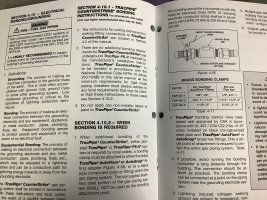Bonding requirements for gas piping are often misapplied or ignored entirely, creating a real safety risk that inspectors, electricians, and gas installers must take seriously. The National Electrical Code (NEC) in Section 250.104(B) requires that any metal piping system, including gas pipes, that is likely to become energized must be bonded to the electrical grounding system. This includes black iron pipe, rigid metallic systems, and any exposed metal piping that runs near energized conductors or electrical equipment. The bonding conductor must be sized using NEC Table 250.122 and should be based on the rating of the electrical circuit most likely to energize the pipe. This means that the required conductor size is not fixed but must match the installation's specific conditions. The bond must terminate to the grounding electrode system or an acceptable point on the service or system ground path.
The issue becomes more serious when CSST, or corrugated stainless steel tubing, is used. Unlike traditional gas piping, CSST is much thinner and more vulnerable to damage from electrical arcing. Nearly every CSST manufacturer requires a dedicated bonding jumper, typically using no less than a #6 AWG copper wire, connected directly to the grounding electrode system. These requirements exist to reduce the chance of arc-induced perforation during a lightning strike or surge event. NEC 110.3(B) mandates that listed products must be installed according to the manufacturer's instructions, which makes this additional bond a code requirement by default. Simply relying on equipment grounding through an appliance is insufficient and does not satisfy the intent or technical requirements of the NEC or the listing.
Despite clear guidance, this is one of residential construction's most overlooked safety issues. Electricians often assume the gas fitter will handle it. Gas installers assume the electrician will do it. In many cases, the bonding jumper is never installed or terminated incorrectly. Its effectiveness is compromised if the bond is not connected to the building's grounding electrode system. Coordination between trades is essential. Electrical inspectors should check for this bond whenever CSST is present, and jurisdictions should consider requiring a final sign-off verifying proper installation. This is not a theoretical risk. CSST bonding failures have resulted in documented fires, and the liability will fall on whoever signed off without catching it. Proper bonding is not optional. It is the only thing standing between a safe system and a potential fire.
The issue becomes more serious when CSST, or corrugated stainless steel tubing, is used. Unlike traditional gas piping, CSST is much thinner and more vulnerable to damage from electrical arcing. Nearly every CSST manufacturer requires a dedicated bonding jumper, typically using no less than a #6 AWG copper wire, connected directly to the grounding electrode system. These requirements exist to reduce the chance of arc-induced perforation during a lightning strike or surge event. NEC 110.3(B) mandates that listed products must be installed according to the manufacturer's instructions, which makes this additional bond a code requirement by default. Simply relying on equipment grounding through an appliance is insufficient and does not satisfy the intent or technical requirements of the NEC or the listing.
Despite clear guidance, this is one of residential construction's most overlooked safety issues. Electricians often assume the gas fitter will handle it. Gas installers assume the electrician will do it. In many cases, the bonding jumper is never installed or terminated incorrectly. Its effectiveness is compromised if the bond is not connected to the building's grounding electrode system. Coordination between trades is essential. Electrical inspectors should check for this bond whenever CSST is present, and jurisdictions should consider requiring a final sign-off verifying proper installation. This is not a theoretical risk. CSST bonding failures have resulted in documented fires, and the liability will fall on whoever signed off without catching it. Proper bonding is not optional. It is the only thing standing between a safe system and a potential fire.


